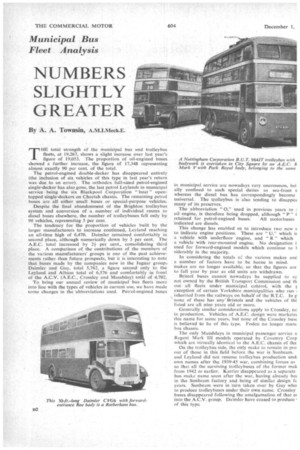Municipal Bus Fleet Analysis
Page 60

If you've noticed an error in this article please click here to report it so we can fix it.
NUMBERS SLIGHTLY GREATER
By A. A. Townsin, A.M.I.Mech.E.
T HE total strength of the municipal bus and trolleybus
Beets, at 19,267, shows a slight increase over last year's figure of 19,053. The proportion of oil-engined buses showed a further increase, the figure of 17,348 representing almost exactly 90 per cent, of the total.
The petrol-engined double-decker has disappeared entirely (the inclusion of six vehicles of this type in last year's return was due to an error). The orthodox full-sized petrol-engined single-decker has also gone, the last petrol Leylands in municipal service being the six Blackpool Corporation " boat " opentopped single-deckers on Cheetah chassis. The remaining petrol buses are all either small buses or special-purpose vehicles.
Despite the final abandonment of the Brighton trolleybus system and conversion of a number of individual routes to diesel buses elsewhere, the number of trolleybuses fell only by 98 vehicles, representing 5 per cent.
The tendency for the proportion of vehicles built by the larger manufacturers to increase continued, Leyland reaching an all-time high of 6,470. Daimler remained comfortably in second place, although numerically down by 3 per cent. The A.E.C. total increased by 21 per cent., consolidating third place. A comparison of the contributions of the members of the various manufacturers' groups is one of the past achievements rather than future prospects, but it is interesting to note that buses made by the companies now in the Jaguar group, Daimler and Guy, total 5,762, a figure second only to the Leyland and Albion total of 6,576 and comfortably in front of the A.C.V. (A.E.C., Crossley and Maudslay) tothl of 4,702.
To bring our annual review of municipal bus fleets more into linewith the types of vehicles in current use, we have made some changes in the abbreviations used. Petrol-engined buses
in municipal service are nowadays very uncommon, bei ally confined to such special duties as sea-front s whereas the diesel bus has correspondingly become universal. The trolleybus is also tending to disappea many of its preserves.
The abbreviation "0," used in previous years to oil engine, is therefore being dropped, although "P" i retained for petrol-engined buses. All motorbuses indicated are diesels.
This change has enabled us to introduce two new s to indicate engine positions. These are " U," which is a vehicle with underfloor engine, and " R " which a vehicle with rear-mounted engine. No designation i used for forward-crigined models which continue to siderably in the majority.
In considering the totals of the various makes and a number of factors have to be borne in mind. makes are no longer available, so that the figures are to fall year by year as old units are withdrawn.
Bristol buses cannot nowadays be supplied to or not owned by the British Transport Commission and th out all fleets under municipal control, with the I exception of certain Yorkshire municipalities who run inherited from the railways on behalf of the B.T.C. In p none of these has any' Bristols and the vehicles of thi listed are all nine years old or more.
Generally similar considerations apply to Crossley, no in production. Vehicles of A.E.C. design were marketer this name for some years, but none of the Crossley bust is believed to be of this type. Foden no longer mant bus chassis.
The only Maudslays in municipal passenger service a Regent Mark III models operated by Coventry Corp which are virtually identical to the A.E.C. chassis of tha
On the trolleybus side, the only make to remain in pro out of those in this field before the war is Sunbeam. and Leyland did not resume trolleybus production until own names after the 1939-45 war, combining forces as so that all the surviving trolleybuses of the former mak from 1942 or earlier. Karrier disappeared as a separate bus make name soon after the war, having already bet in the Sunbeam factory and being of similar design fc years. Sunbeam were in turn taken over by Guy who to produce trolleybuscs under their own name. Crossley buses disappeared following the amalgamation of that et into the A.C.V. group. Daimler have ceased to produce of this type,
































































































































